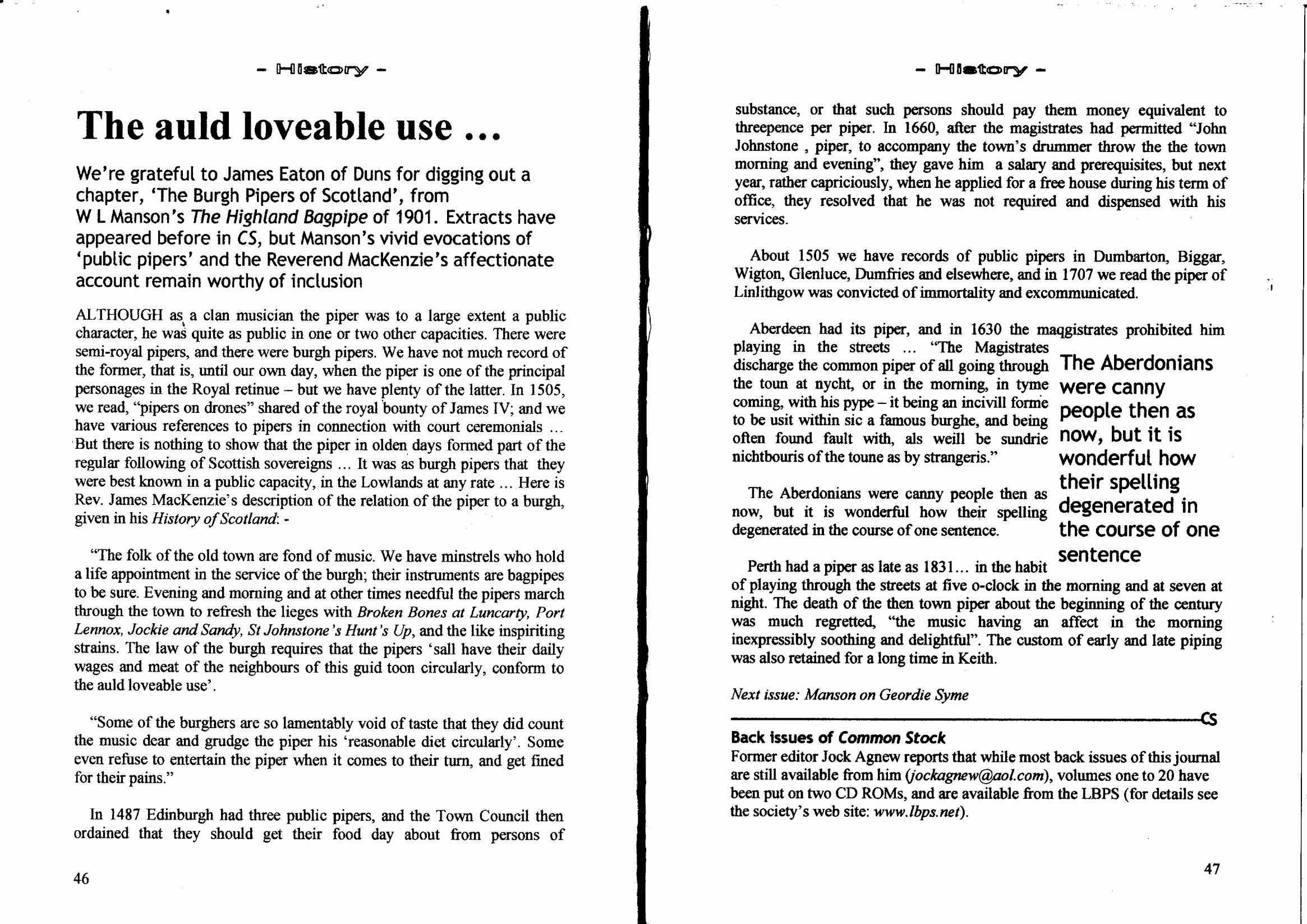The Auld Loveable Use
>

We’re grateful to James Eaton of Duns for digging out a chapter, ‘The Burgh Pipers of Scotland’, from W L Manson’s The Highland Bagpipe of 1901. Extracts have appeared before in CS, but Manson’s vivid evocations of ‘public pipers’ and the Reverend Mackenzie's affectionate account remain worthy of inclusion
ALTHOUGH as a clan musician the piper was to a large extent a public character, he was quite as public in one or two other capacities. There were semi-royal pipers, and there were burgh pipers. We have not much record of the former, that is, until our own day, when the piper is one of the principal personages in the Royal retinue - but we have plenty of the latter. In 1505, we read, “pipers on drones” shared of the royal bounty of James IV; and we have various references to pipers in connection with court ceremonials ... But there is noth- ing to show that the piper in olden days formed part of the regular following of Scottish sovereigns ... It was as burgh pipers that they were best known in a public capacity, in the Lowlands at any rate ... Here is Rev. James Mackenzie’s description of the relation of the piper to a burgh, given in his History of Scotland:-
“The folk of the old town are fond of music. We have minstrels who hold a life appointment in the service of the burgh; their instruments are bagpipes to be sure. Evening and morning and at other times needful the pipers march through the town to refresh the lieges with Broken Bones at Luncarty, Port Lennox, Jockie and Sandy, St Johnstone's Hunt’s Up, and the like inspiriting strains. The law of the burgh requires that the pipers ‘sall have their daily wages and meat of the neighbours of this guid toon circularly, conform to the auld loveable use’.
“Some of the burghers are so lamentably void of taste that they did count the music dear and grudge the piper his ‘reasonable diet circularly’. Some even refuse to entertain the piper when it comes to their turn, and get fined for their pains.”
In 1487 Edinburgh had three public pipers, and the Town Council then ordained that they should get their food day about from persons of substance, or that such persons should pay them money equivalent to threepence per piper. In 1660, after the magistrates had permitted “John Johnstone , piper, to accompany the town’s drummer throw the town morning and
evening”, they gave him a salary and prerequisites, but next year, rather capriciously, when he applied for a free house during his term of office, they resolved that he was not required and dispensed with his services.
About 1505 we have records of public pipers in Dumbarton, Biggar, Wigton, Glenluce, Dumfries and elsewhere, and in 1707 we read the piper of Linlithgow was convicted of immorality and excommunicated.
Aberdeen had its piper, and in 1630 the magistrates prohibited him playing in the streets ...
“The Magistrates discharge the common piper of all going through the toun at nycht, or in the morning, in tyme coming, with his pype - it being an incivill forme to be usit within sic a famous burghe, and being often found fault with, als weill be sundrie nichtbouris of the toune as by strangeris.”
The Aberdonians were canny people then as now, but it is wonderful how their spelling degenerated in the course of one sentence.
The Aberdonians were canny people then as now, but it is wonderful how their spelling degenerated in the course of one sentence
Perth had a piper as late as 1831... in the habit of playing through the streets at five o-clock in the morning and at seven at night. The death of the then town piper about the beginning of the century was much regretted, “the music having an affect in the morning inexpressibly soothing and delightful”. The custom of early and late piping was also retained for a long time in Keith.
Next issue: Manson on Geordie Syme
